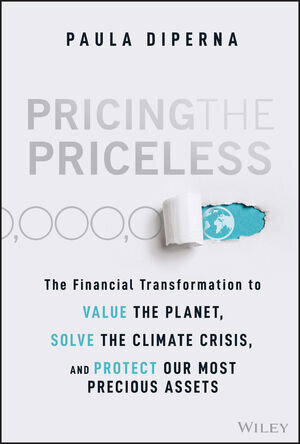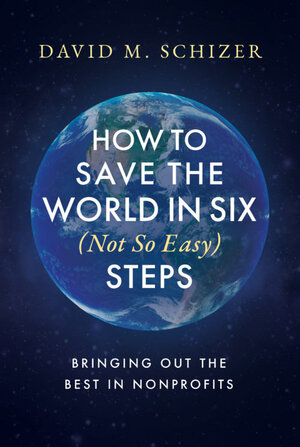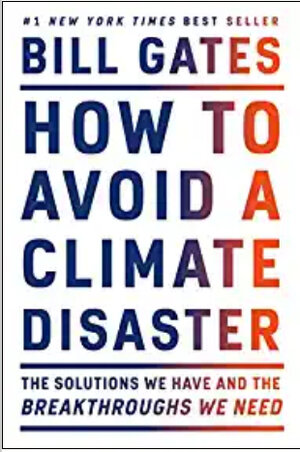Pricing the Priceless: The Financial Transformation to Value the Planet, Solve the Climate Crisis, and Protect Our Most Precious Assets
What is a fair price for a metric ton of Earth’s atmosphere? What is the sun worth?
These might seem like ridiculous, unanswerable questions, but such inquiries are at the heart of Paula DiPerna’s Pricing the Priceless: The Financial Transformation to Value the Planet, Solve the Climate Crisis, and Protect Our Most Precious Assets. The environmental and philanthropic policy advisor explores an economic contradiction most of us routinely ignore: How can we value the indispensable—without which life on Earth cannot exist—at zero but dispensable production in the trillions?
If they were like most commodities, everything from the value of the air we breathe, to keeping mangrove trees along the shoreline of Myanmar, to the planet’s biodiversity, to irreplaceable works of art owned by a public museum would be valued at what the market would bear. The key to combating climate change, DiPerna writes, is pricing, because people don’t typically value what they don’t pay for. In Pricing the Priceless, DiPerna argues that the world needs a “market” for protecting the environment and addressing climate change. Conventional economic studies do not address the value of “externalities,” but “booking the unbooked” from an accounting standpoint led to what is now known as environmental economics. And she would add items such as good health, social coherence and harmony, educational advancement, safe streets, reliable fire departments, and art and culture—areas the nonprofit sector is intimately involved with—to the list of priceless assets that must be valued appropriately so they are not the first to be tossed aside during challenging economic times.
The key to combating climate change, DiPerna writes, is pricing, because people don’t typically value what they don’t pay for.
“Carbon markets, carbon pricing, and other financial innovations (including new forms of insurance, bonds, investment funds, and indices) are part of this revolution and a simultaneous reprogramming of the financial markets of the world so that inanimate black-red ink balance sheets no longer function in an isolated arena undefined and unscrutinized by the needs of people and the planet,” she writes. Without setting a price, an asset is invisible from a financial standpoint, she argues. “Pricing…[illuminates] the value of saving and protecting [an asset], and the cost of losing it.”
DiPerna’s entire career has been spent in and around the social sector, with a focus on the environment. In the 1980s, she worked as vice president for international affairs at the Cousteau Society with oceanographer and explorer Jacques-Yves Cousteau, who struck her as remote when the Exxon Valdez ran aground in Alaska in 1989, leaching the largest oil spill in U.S. history. She asked him why he wasn’t upset about the environmental tragedy. “I am upset,” he responded, “but the real tragedy is taking that oil out of the ground at today’s prices.”
Yet again, nature was undervalued. “Underpricing indicates disrespect,” DiPerna writes.
Using the tools of journalism as well as memoir writing, in Pricing the Priceless DiPerna takes readers into the mangrove jungles of Myanmar, the halls of Vatican City, and high-level negotiations to create a carbon credit exchange in China, all with an eye for translating complex concepts into comprehensible ideas for readers who are not so eco-savvy.
DiPerna takes readers into the mangrove jungles of Myanmar, the halls of Vatican City, and high-level negotiations to create a carbon credit exchange in China, all with an eye for translating complex concepts into comprehensible ideas for readers who are not so eco-savvy.
As she tells it, new metrics and markets must be designed to steward nature—not expend it. In Myanmar, she was among a team of environmental leaders invited in 2014 to help ascribe a value to the country’s mangrove forests, much of which had been cut to clear land or burned down for wood or charcoal. According to DiPerna, studies demonstrated that mangroves contributed unseen, unheralded value—in addition to the commercial value of the inshore and offshore prawn and crustacean catch—such as providing elephant habitats and protecting the watershed. “Holding soil is a high-value ecosystem service,” she writes, “stemming erosion and siltation, all of which can foul drinking water and clog up plumbing where it does exist, as well as water flow needed for hydropower plants, especially important to avoid fossil fuel burning and which contributed nearly 60 percent of Myanmar’s electricity at the time.” Yet such findings were not enough to stop deforestation as the country fell into political turmoil.
Importantly, each chapter of Pricing the Priceless provides insight into the complexities of the politics around climate change as well as the quixotic economics of the environment. While there may be moments when she beats the same drum a little too frequently, at least the beat is consistent.
A lifelong New Yorker, DiPerna has served as president of the Joyce Foundation in Chicago and as executive vice president of the Chicago Climate Exchange, led by Richard Sandor, which worked to establish environmental markets around the world and helped create emissions trading. In the wake of the 9/11 attacks, she joined the Century Foundation and served on its Project on Homeland Security and the Working Group on the Public Right to Know and later wrote Media, Charity, and Philanthropy in the Aftermath of September 11, 2001, about media coverage of the philanthropic response to 9/11, the public relations troubles of the American Red Cross in the months following the attacks, public perceptions of philanthropy post-9/11, and the role of the nonprofit sector in the context of homeland security.
Importantly, each chapter of Pricing the Priceless provides insight into the complexities of the politics around climate change as well as the quixotic economics of the environment.
In short, she knows how to share a story and how to approach key players.
Perhaps that point is exemplified at the bookend moments. She opens Pricing the Priceless addressing a response to Pope Francis soon after he released Laudato Si, the Vatican’s environmental encyclical. Her concern, she wrote, was his dismissal of carbon pricing. But within four years—in the closing chapter of the book—after she had presented her arguments to the pope’s aides and later to the pope himself, the pontiff not only stated that “[c]arbon pricing is essential if humanity is to use the resources of creation wisely,” he also committed the Vatican to carbon neutrality.
Pricing the Priceless makes you believe that humanity might be able to overcome the climate crisis before all is lost.
Matt Sinclair is editor of Philanthropy News Digest.










